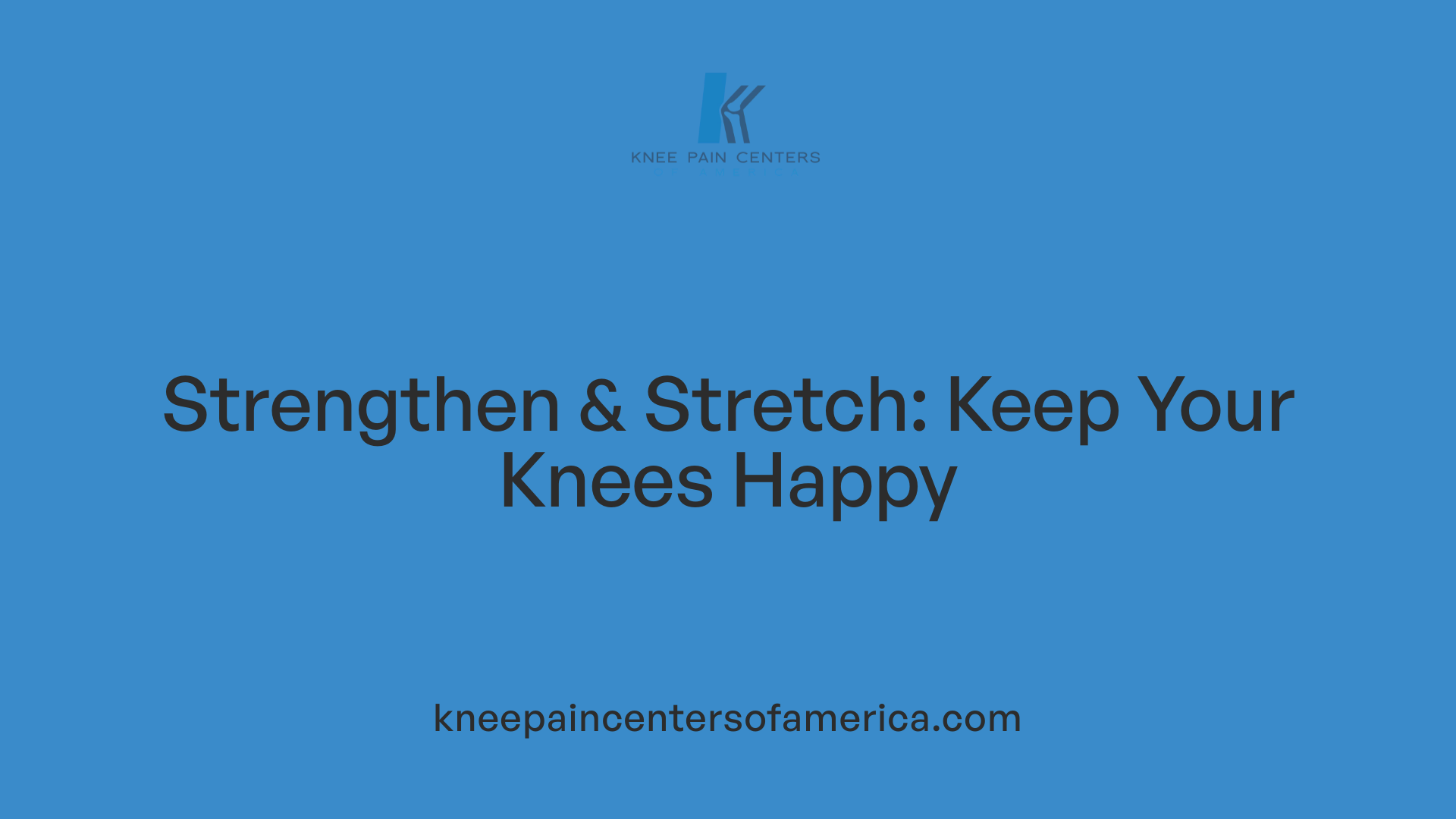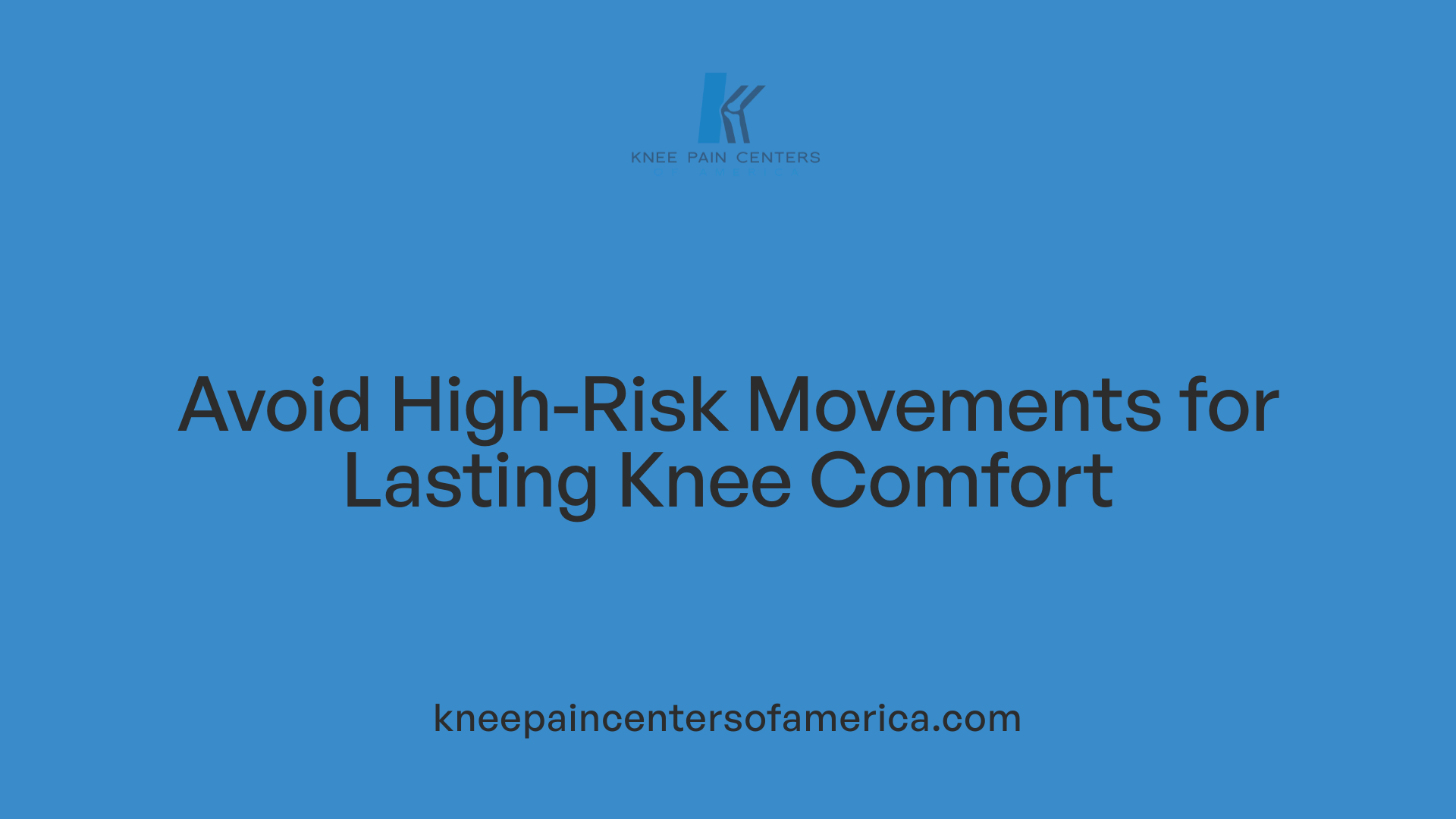Understanding and Preventing Knee Pain in Active Lifestyles
Knee pain during exercise can be a frustrating barrier to maintaining an active lifestyle. Whether you're new to fitness or an experienced athlete, understanding how to protect your knees is crucial for long-term joint health and injury prevention. This comprehensive guide offers practical tips, safe practices, effective exercises, and expert advice to help you exercise safely while minimizing knee discomfort and reducing the risk of injury.
Low-Impact Activities to Minimize Knee Stress
 Engaging in low-impact exercises offers a gentle yet effective way to maintain knee joint health and prevent injuries. Activities like cycling, swimming, using elliptical machines, and participating in water aerobics are especially beneficial because they reduce stress on the knee joints while promoting strength and flexibility.
Engaging in low-impact exercises offers a gentle yet effective way to maintain knee joint health and prevent injuries. Activities like cycling, swimming, using elliptical machines, and participating in water aerobics are especially beneficial because they reduce stress on the knee joints while promoting strength and flexibility.
Cycling on a stationary bike or outdoor cycling helps improve knee joint efficiency by strengthening the muscles around the knee, hips, and pelvis. These muscles stabilize the joint, leading to better movement mechanics and reduced injury risk. Swimming and water aerobics provide resistance training without putting weight-bearing stress on the knees, making them ideal options for individuals with osteoarthritis or those recovering from knee injuries.
Why do low-impact activities help in preventing knee problems? They allow users to exercise regularly without suffering from excessive joint strain. This reduces the likelihood of overuse injuries like runner's knee or tendinitis. Regularly engaging in such activities enhances circulation, joint lubrication, and muscle support, all crucial for knee health.
Choosing the right surfaces is critical to protect your knees. Hard surfaces like sidewalks, concrete, or asphalt can intensify joint impact and accelerate wear. Instead, opt for softer tracks, treadmill surfaces, or even indoor gyms with cushioned floors. These provide more forgiving terrain, absorbing shocks that otherwise might harm your knees.
| Exercise Type | Primary Benefits | Surface Preference | Additional Tips |
|---|---|---|---|
| Cycling | Builds muscle, improves joint efficiency | Soft, smooth surfaces, stationary bikes | Adjust seat height for proper alignment |
| Swimming | Enhances strength, minimizes impact | Pool with non-slip floors | Use proper swimming techniques |
| Elliptical training | Cardio workout with minimal knee stress | Indoor gym equipment | Maintain controlled motion and posture |
| Water aerobics | Resistance training, joint protection | Shallow water | Perform gentle, controlled movements |
Wearing supportive shoes with adequate cushioning and shock absorption further reduces impact on the knees during any activity. Custom orthotics or shoe inserts can provide additional support, especially if foot problems contribute to knee strain.
Avoid exercises that involve deep knee bending, such as full squats or lunges, during flare-ups of knee pain. Modified positions like half squats or gentle leg lifts are safer options for maintaining strength without risking further injury.
Remember, warming up your muscles with a slow jog or brisk walk for 5-10 minutes, followed by gentle stretching of the calves, quadriceps, and hamstrings, helps prepare your body for activity and protects against injuries. Incorporate these routines as part of your warm-up and cool-down.
Listening to your body is essential. If you experience discomfort or pain during activity, stop immediately and rest. Persistent symptoms warrant consultation with a healthcare professional to adjust your exercise plan accordingly.
Overall, adopting a routine that emphasizes low-impact activities, proper surface choices, supportive footwear, and careful exercise techniques can significantly contribute to knee health and longevity—making physical activity sustainable and effective for everyone.
| Activities Recommended | Impact Level | Suitable For | Notes |
|---|---|---|---|
| Cycling | Low | All fitness levels, knee issues | Use proper seat height and bike fit |
| Swimming | Low | Knee pain, arthritis sufferers | Use float aids for better support |
| Elliptical training | Low | Cardio, joint preservation | Control resistance and stride length |
| Water aerobics | Low | General health, joint pain relief | Perform gentle, controlled routines |
In summary, focusing on low-impact exercises performed on forgiving surfaces while supporting your knees with the right gear and warm-up routines can help you stay active safely and effectively, ensuring long-term joint health.
Proper Warm-Up, Stretching, and Surface Selection

Why is warming up with a light jog or cycling important?
Engaging in a gentle warm-up such as cycling or a slow jog for about 5 to 10 minutes helps prepare the muscles and joints for exercise. This activity boosts blood circulation, which lubricates the knee joints and loosens the muscles around them. An increased blood flow reduces the risk of strain or injury during more intense workouts. This initial phase sets a safe foundation for the activity ahead.
How does stretching help protect the knees?
Stretching all the leg muscles, including calves, quadriceps, and hamstrings, both before and after exercise, increases flexibility and joint range of motion. Proper stretching helps prevent muscle tightness that can pull on the knee joint, potentially causing pain or injury. Targeted stretches like hamstring and quadriceps stretches are especially effective in reducing knee stress. Incorporating stretching routines—lasting around 20 to 30 seconds per stretch—can significantly decrease the risk of strains and other injuries.
What are better surface choices for exercising?
Choosing softer surfaces such as a treadmill or a soft track is gentler on your knees compared to hard surfaces like sidewalks or concrete. Hard surfaces increase impact forces on the joints, especially during high-impact activities such as running or jumping, which can lead to discomfort or injury over time. Soft, even surfaces help absorb shock and reduce stress on the knees, making regular exercise safer and more comfortable.
| Surface Type | Impact Level | Suitable For | Additional Notes |
|---|---|---|---|
| Sidewalks/Concrete | High | Not recommended for joint health | Increased impact can worsen knee issues |
| Treadmill | Low to moderate | Safe for most exercisers | Cushioned surface reduces impact |
| Soft track | Low | Ideal for running and walking | Gentle on knees, supports consistent pace |
| Grass or dirt path | Moderate | Good for walking, light jogging | Absorbs shock, decreases impact stress |
What safe exercises should I practice?
To shield your knees from strain, avoid high-impact routines involving excessive knee bending or sudden movements. Focus on low-impact activities that emphasize controlled movements. Using proper technique and avoiding activities that involve sharp twists, rapid stops, or hard landings can prevent injuries like ACL tears. Consulting professionals for personalized guidance is advisable, especially if you have existing knee issues.
How does surface choice and warm-up contribute to knee health?
Combined, warming up and selecting softer exercising surfaces create a safer environment for your knees. Proper warm-up elevates joint and muscle readiness, while softer surfaces minimize shock and repetitive stress. These practices contribute to maintaining joint health, preventing overuse injuries, and ensuring long-term activity enjoyment.
Muscle Strengthening and Flexibility Exercises

What exercises and stretches can help prevent or alleviate knee pain?
Targeted exercises and stretches are essential tools for maintaining knee health and reducing pain. Strengthening muscles that support the knee, such as the quadriceps, hamstrings, and hip muscles, can provide stability and decrease stress on the joint. Simple exercises like wall squats, where you lean against a wall and slide down into a half-squat position, can strengthen the thigh muscles without excessive strain.
Thigh contractions, or isometric exercises, help build muscle endurance smoothly. These involve tightening the thigh muscles while keeping the leg still, which enhances support for the knee. Hamstring curls, whether done with or without resistance, focus on the back of the thigh, an area often weak in people with knee issues.
Stretching routines also play a vital role. Regularly stretching the calves, quadriceps, and hamstrings increases flexibility, reduces muscle tension, and improves joint mobility. Exercises such as calf stretches, where you lean against a wall with one foot back to stretch the calf, and hamstring stretches, where you sit and reach toward your toes, are easy yet effective.
Quadriceps stretches, where you stand on one leg and pull the other foot toward your buttock, are particularly beneficial for relaxing the front thigh muscles. Additionally, stretching the iliotibial (IT) band can prevent lateral knee pain.
Incorporating these exercises into your routine, alongside low-impact activities like swimming or cycling, helps promote overall joint health. Ensuring a proper warm-up before activity and cool-down stretching afterward enhances their benefits.
Consistent practice of muscle strengthening and flexibility exercises supports the joint, prevents overuse injuries, and alleviates conditions like patellofemoral pain or osteoarthritis. It’s advisable to consult with a healthcare professional or physical therapist for personalized guidance and to avoid exercises that may worsen existing pain.
Use of Supportive Gear and Proper Technique

Should I wear a knee brace during exercise?
Deciding whether to wear a knee brace during exercise depends on your individual health status and activity level. For those recovering from a knee injury or dealing with chronic knee pain, a brace can offer much-needed support and stability. It helps prevent further injury by stabilizing the joint during physical activities, especially high-impact or demanding movements.
For individuals without existing knee problems engaging in low-impact exercises such as swimming, cycling, or yoga, a knee brace might not be necessary. It is important to note that wearing a brace is not a substitute for strengthening muscles around the knee or practicing proper exercise techniques.
The decision should always be made in consultation with a healthcare professional. They can assess your knee condition and recommend the appropriate type of support and whether it is beneficial during specific activities.
Importance of wearing supportive shoes with cushioning and shock absorption
Proper footwear plays a crucial role in knee health. Supportive athletic shoes with good cushioning help absorb shock and reduce impact during activities like walking, jogging, or using gym equipment. Shoes that fit well and provide proper arch support minimize abnormal gait patterns, decreasing uneven stress on the knees.
Worn-out shoes lose their cushioning and support, increasing the risk of pain and injury. Regularly replacing your athletic shoes ensures optimal support. Additionally, using shoe inserts or custom orthotics can address specific foot biomechanics that might contribute to knee problems.
Practicing proper exercise form—e.g., correct squat posture and avoiding over-bending
Executing exercises with proper form is vital in protecting your knees from unnecessary strain. For example, during squats, stand with feet shoulder-width apart, keep your heels on the ground, and lower your body by bending the hips and knees while keeping your back straight. Never let your knees move excessively forward past your toes or bend more than 90 degrees.
Avoid deep squats or lunges that excessively bend the knees, particularly if you experience pain. Instead, perform modifications like half squats or partial lunges, which reduce stress without compromising effectiveness.
Importance of adapting exercises to individual needs and limitations
Every person’s knee condition and physical capacity are different. It is crucial to tailor exercise routines accordingly. Start slowly, especially if you have existing issues or are new to exercise.
Consult with a physical therapist or healthcare professional for guidance. They can help modify standard workouts, recommend low-impact activities, and show you proper techniques to prevent injury.
Creating a customized plan ensures your exercise routine is safe, sustainable, and beneficial for your knee health.
| Aspect | Recommendations | Details |
|---|---|---|
| Supportive Gear | Wear supportive shoes | Ensure shoes have cushioning and proper fit; replace worn shoes regularly |
| Knee Braces | Consider usage | Use especially during high-impact exercises or if recovering from injury; seek professional advice |
| Exercise Technique | Practice proper form | Follow correct posture for squats, lunges, and other movements; avoid over-bending |
| Personalization | Adapt routines | Adjust exercises to your needs; consult healthcare providers for personalized guidance |
By combining supportive gear with correct exercise techniques and tailored routines, you help safeguard your knees while maintaining an active lifestyle.
Avoiding High-Risk Movements and Overuse

What exercises to avoid with knee pain?
If you experience knee pain, it’s crucial to steer clear of exercises that place excessive strain on the joint. High-impact activities such as running, jumping, and kickboxing can aggravate knee injury or discomfort due to the repetitive pounding and shock they deliver.
Exercises involving deep bending of the knees, like full squats, deep lunges, and full-arc knee extensions under heavy load, should be avoided. These movements increase stress on the kneecap and surrounding tissues, possibly worsening pain or injury. Jarring activities, especially those that involve sudden stops, quick pivots, or twisting motions—common in sports like soccer, basketball, and tennis—also heighten the risk of injury.
Jumping exercises, including box jumps, jump squats, and high-impact plyometrics, contribute to impact stress on the knees and should be replaced with lower-impact alternatives. Running on very hard surfaces such as concrete can cause additional joint stress, so softer surfaces or elliptical training are preferable.
Instead of high-impact routines, opt for gentle, low-impact exercises like swimming, water aerobics, or cycling. These activities help maintain cardiovascular fitness and strengthen the muscles around the knee without excessive pressure.
Preventing overuse injuries involves not only avoiding risky movements but also incorporating proper warm-up routines, gradually increasing exercise intensity, and ensuring adequate rest between sessions. Consulting a healthcare professional or physical therapist can help craft a safe exercise plan tailored to knee health.
Sticking to these guidelines can significantly reduce the risk of further injury and support long-term knee joint health.
Maintaining Long-Term Knee Health
Preventing knee pain during exercise is a combination of choosing the right activities, proper warm-up, strengthening supportive muscles, wearing appropriate gear, and practicing safe techniques. Consistently following these guidelines can help you stay active, enjoying your preferred exercises without discomfort or injury. Remember that if you experience persistent or worsening pain, consulting a healthcare professional is essential. Protecting your knees today ensures a healthy, mobile tomorrow, enabling continued activity and fun well into the future.
References
- 4 Tips to Protect Your Knees While Exercising
- 5 Essential Steps for Protecting Your Knees During Exercise
- Take control of your knee pain - Harvard Health
- Knee exercises for runners - NHS
- Five Ways to Protect Your Knees While Exercising
- 10 Visuals of Exercises to Help Relieve Knee Pain - Healthline
- Five Tips for Preventing Runner's Knee - HSS





